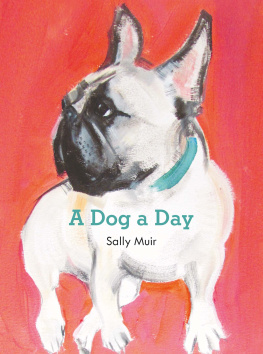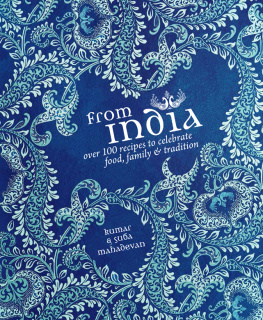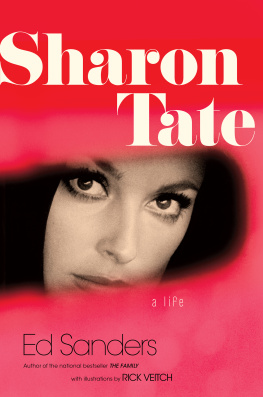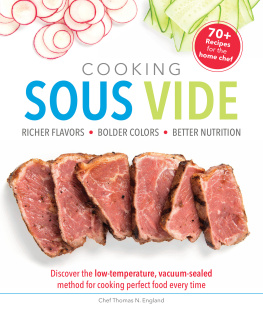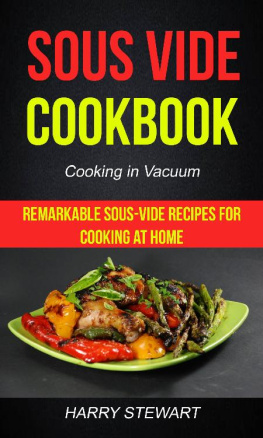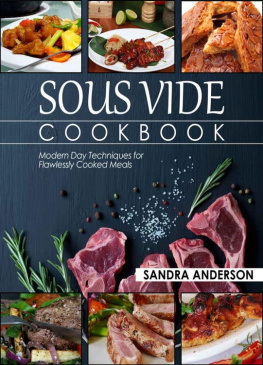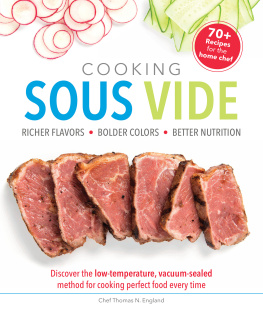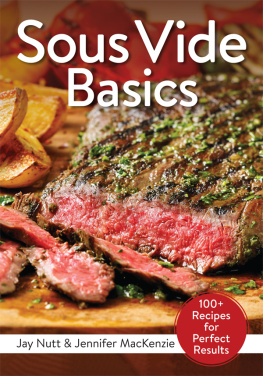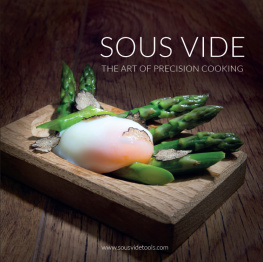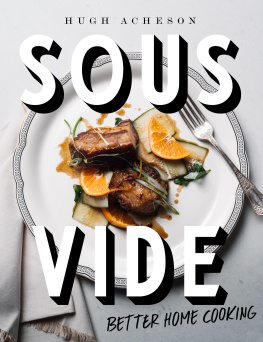UNDER PRESSURE
cooking sous vide
THOMAS KELLER
JONATHAN BENNO, COREY LEE, AND SEBASTIEN ROUXEL
WITH SUSIE HELLER, MICHAEL RUHLMAN, AND AMY VOGLER
PHOTOGRAPHY BY DEBORAH JONES
INTRODUCTION BY HAROLD McGEE

To all the chefs who have inspired and mentored me throughout my careerthose who, like Roland Henin, helped guide me and remind me why we cook: to nurture others.
And foremost, to all those who have worked tirelessly at The French Laundry, per se, Bouchon, Bouchon Bakeries, and Ad Hoc, both past and present, for their contributions to the evolution of our restaurants. Only through such a collaborative effort is this book possible.
THOMAS KELLER
To my mother, Margery; my father, Howard; and my wife, Elizabethfor supporting me in life, education, and cuisine.
JONATHAN BENNO
To the cooks at The French Laundry, past and present, with whom these recipes were developed.
COREY LEE
To my wife, Andrea, and daughters, Ava and Grace, for their constant support. To my grandmother, Marie, and my aunt, Jeannette, whose passions for cuisine inspire my own. And to my staff.
SEBASTIEN ROUXEL
CONTENTS
BY BRUNO GOUSSAULT
BY HAROLD McGEE

Though I am a scientist and not a cook, I love the art of cooking, the techniques, the equipment, the organization, and the proud and intrepid men who continually go back and back to improve on their work. In cooking, success is not extemporized. It is built on precision, the quest for truth, and the purity of flavors and textures.
My life with sous vide over the years had been aligned to its use in industry, but nearly thirty years ago I had the good fortune to work with Jol Robuchon, when I was able to display the many benefits chefs might enjoy when they understood the power of precise temperatures in cooking.
Thanks to my friend Stanislas Vilgrain, I was given the opportunity to come live in the United States, where I discovered another world of cooking, another perception of culinary science, and, in this, Thomas was an inestimable mentor. I met Thomas and his kitchen staff when several of his recipes were being adjusted and reworked to fit within the framework of sous vide cooking for Cuisine Solutions. I trained his staff in both of his restaurants, where I found the same exactness I had experienced with the Michelin-starred chefs of France.
Here at last is an excellent book about the technique of cooking sous vide. Its both thoughtful and well documented, and it has been written by a chef of immense talent and modesty. Every page is a tribute to his open-mindedness and to his preciseness, and to the talents of those he works withincluding Harold McGee, who has made the science so easy to understand.
Due to its exactness, sous vide cooking ushers us into the realm of temperature control so far unprecedented. And it is likely to continue to amaze us in the future as its usage evolves, and as more chefs embrace sous vide for their own imaginative ends. It is already playing an important part in a restaurant kitchens everyday repertoire. It is clearly going to become the pillar of food safety. A packaged product wherein all vegetative types of pathogenic bacteria have been destroyed and for which the risk of recontamination has been all but eradicated is a safer product.

Bruno Goussault
Chief Scientist
A POWERFUL NEW COOKING TOOL
HAROLD MCGEE
THIS BOOK INTRODUCES AMERICAN COOKS TO ONE OF THE MOST IMPORTANT culinary innovations of modern times. And what is this great advance? A way of heating foods precisely. At last! Heat is the most important ingredient in cooking, the one that can transform all the others into something deliciousor into something dry and dull. Its also the ingredient that has been the hardest to measure or control. But in this book, Thomas Keller and his chefs illustrate the powers of precision heating with dozens of dishes that wouldnt be as fine, or even conceivable, without it.
This new heating method is the twenty-first-century version of the bain-marie, or water bath, which goes back to medieval times. It goes by the name sous vide, meaning under vacuum, and it involves two new appliances and two basic steps. First you use a vacuum-packing machine to seal food tightly in a plastic bag. Then you immerse the bag in a water bath heated exactly to the optimal cooking temperature. The vacuum-packed bag hugs the food, protecting it from contact with the water while transferring the heat directly from the hot water. The bath is regulated by a device called an immersion circulator, a combination of thermometer, heater, and pump that monitors the temperature, heats the water just enough to maintain the temperature you set it to, and moves the water around so the temperature is even throughout the bath.
Sous vide isnt really the best name for this method, because the vacuum-packing the term actually refers to is less important than temperature control. Precision cooking would be a better term. But for now, sous vide is it.
The heart of sous vide cooking is the controlled application of relatively low heatjust hot enough to cook the food properly, no more. A pot of boiling water or a hot oven cooks food at a higher temperature, so that by the time the center of the food reaches the proper temperature, the outside is at least partly overcooked. If you dont get the timing just right, meats end up dry and vegetables mushy. But if you heat food in water maintained at exactly the temperature you want the food itself to reach, it will end up cooked properly throughout.
As discussed on vide cooking more or less faded from the scene until 2000, when Grard Bertholon, a French chef turned food-company executive, demonstrated its virtues to Daniel Boulud, Thomas Keller, and other leading American chefs and showed them how to use it safely. The chefs then discovered what remarkable things they could do with it, and the word spread.
Its fitting that the first book to present the sous vide method to English-speaking cooks comes from Thomas Keller, one of the most creative and admired chefs of his generation, whose cooking is deeply rooted in the French tradition. No one is in a better position to show that, far from being some passing high-tech fad, sous vide is a lasting contribution to fine cooking, a technique that makes it possible to cook foods more consistently and delicately than ever before.
The most important and obvious benefit of temperature control is that it ensures against under- or overcooking food. But as theyve experimented with degree-by-degree precision cooking, chefs have made some unanticipated discoveries. In the past, weve defined the doneness of meats and fish and eggs in terms of three or four broad categories spanning a total temperature range of 10 degrees C (18 degrees F) or more. Yet it turns out that just 1 degree C (2 or 3 degrees F) can make a difference! Cooking salmon gently keeps it moist, but salmon cooked to 48.9C (120F) is moist and slightly tacky, while salmon cooked to 50.6C (123F) is slightly firmer and no longer tacky. An egg soft-cooked at 60C (140F) is barely jelled throughout; at 62.8C (145F), the yolk is actually firmer than the surrounding white. Sous vide cooking has opened up new realms of texture and flavor that werent discernible before and that still arent fully understood.




